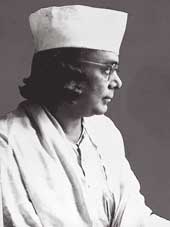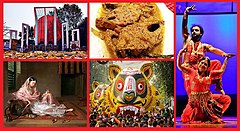History of Bengali literature
| Bengali literature বাংলা সাহিত্য | |
|---|---|
 | |
| Bengali literature | |
| By category Bengali language | |
| Bengali language authors | |
| Chronological list – Alphabetic List | |
| Bengali writers | |
| Writers – Novelists – Poets | |
| Forms | |
| Novel – Poetry – Science Fiction | |
| Institutions and awards | |
| Literary Institutions Literary Prizes | |
| Related Portals Literature Portal Bangladesh Portal | |
| Part of a series on the |
| Culture of Bengal |
|---|
 |
| History |
|
Mythology and folklore |
| Cuisine |
|
Genres Institutions Awards |
|
Music and performing arts Folk genres Devotional Classical genres Modern genres People Instruments Dance Theater Organizations People |
|
|
| Part of a series on |
| Bengalis |
|---|
 |
|
Bengali homeland |
|
|
This is a History of Bengali literature.
Ancient Age[edit]
Charyapada[edit]
The first works in Bengali, written in Old Bengali,[1] appeared between 8th and 10th centuries C.E. The collection of these words is generally known as the Charyapada. There are as many as 50 to 51 songs. But we got only 46 and a tore one of them(23). These are mystic songs composed by various Buddhist seer-poets: Luipada, Kanhapada, Kukkuripada, Chatilpada, Bhusukupada, Kamlipada, Dhendhanpada, Shantipada, Shabarapada, Arcjhanpada, Bhadehpada, Dharmapada, Dhombipada, Mohidharpada, Khonkonpada, Binapada,Birupada, Thantrikpada etc. Among them Kanhapada composed highest number of songs,13. And the second position goes to Bhusukupada,8.We haven't got any songs composed by Thantrikpada. The first song is composed by Luipada. The famous Bengali linguist Haraprasad Shastri discovered the palm leaf Charyapada manuscript in the Nepal Royal Court Library in 1907.
Dark Age[edit]
Dark Age or Blank age in Bengali literature refers to the period between 1200–1350 AD.[2] In 1200 AD Afghani (Turkic) ruler Muhammad bin Bakhtiyar Khilji invaded the Bengal region and ruled for around 150 years. No written records of Bengali literature exist from this period.[3] The period is termed Dark Age by linguist Sukumar Sen.[4]
Some linguists do not acknowledge the existence of Dark Age as some literature were claimed to be written in this period including Dak o Khanar Vachan, Ramai Pandit's narrative poem Sunyapurana.[5][6]
Middle Age[edit]
Early Vaishnab literature[edit]
Shrikrishna Kirtana[edit]
A torn manuscript of the Sreekrishna Kirtana Kabya was discovered by Basanta Ranjan Roy Biddyadwallav in 1909 from the house of Debendranath Mukherjee at a village named Kakinla in the district of Bankura, West Bengal. Shreekrishna Kirtana Kabya was composed by Boru Chandidas. It was first published under the composition made by Basontoh Ranjan Roy in 1916. While Charyapada shows us the most ancient example of Bengali language, Shreekrishna Kirtana depicts a new kind of speech style very clearly. Shreekrishna Kirtana have as many as 13 parts. It depicted the romantic relationship of Radha and Krishna. According to Suniti Kumar Chatterji, "The Grammar of the speech of the Shreekrishna Kirtana gives a clue to many of the forms of New Bengali".
Padavali of Chandidas[edit]
There are a large number of Bengali padas related to the love of Radha and Krishna with the bhanita of Chandidas, with three different sobriquets—Baḍu, Dvija, and Dina—along with his name, as well as without any sobriquet. It is not clear whether these bhanitas actually refer to the same person or not.
Early translations from Sanskrit[edit]
- Sri Ram Panchali of Krittibas Ojha
- Sri Krishna Vijay of Maladhar Basu
Early Mangalkavyas[edit]
The Mangalkavyas were written to popularise the worship of a number of deities, mostly Manasa and Chandi. This genre of Bengali literature includes the majority of works of the medieval Bengali literature. This genre includes the following subgenres:
Hagiography of Sri Chaitanya[edit]
Chaitanya Mahaprabhu[edit]
One of the prominent figures of the Bengali literature in the early sixteenth century was the Vedic spiritual leader Chaitanya Mahaprabhu, who lived from 1486 to 1534. He was devoted adherent of Krishna bhakti and founded Gaudiya Vaishnavism, which was a religious movement based on the belief that Sri Krishna is the only God.[7][8] His teachings included chants that are now identified with Bengali literature and identity like the famous Hare Rama, Hare Krishna mantra. As Gaudiya Vaishnavism was propagated by his disciples such as Sanātana Gosvāmin, Rūpa Gosvāmin, Jīva Gosvāmin, and Gopala Bhaṭṭa Gosvāmin, among other followers,[9][10] songs were written and these also became part of the Bengali literature, along with the compiled biographical accounts and teachings Chaitanya Mahaprabhu.[8] Chaitanya's influenced persisted until the nineteenth century when his religious teachings were considered a factor in the emergence of the Bengal Renaissance.
Chaitanya Bhagavat of Vrindavana Dasa[edit]
The Chaitanya Bhagavata—written by Vrindavana Dasa—is the earliest hagiographical work on the Vaishnava saint Chaitanya Mahaprabhu. Chaitanya is considered by his followers to be an incarnation of Radha and Krishna combined, and is a pivotal figure of the Hindu sect Gaudiya Vaishnavism.
Chaitanya Mangal of Jayananda[edit]
Chaitanya Mangal of Lochan Dasa[edit]
Chaitanya Charitamrita of Krishnadasa Kaviraja[edit]
The Chaitanya Charitamrita is the magnum opus of the Bengali saint/author Krishna Dasa Kaviraja (1496-? CE). The book, a hybrid Bengali and Sanskrit biography, documents the life and precepts of Chaitanya Mahaprabhu.
As a religious text, the Chaitanya Charitamrita is the main theological resource for Gaudiya Vaishnava theology, and is divided into three sections; Adi-lila, Madhya-lila, and Antya-lila.
Later Vaishnab literature[edit]
- Padavali of Balaram Dasa
- Padavali of Jnandasa
- Padavali of Govinda Dasa Kabiraj
Later Mangal Kavyas[edit]
Translation of Mahabharata[edit]
- Kabindra Parameswara
- Srikar Nandi
- Kashiram Das
Muslim poets of the 17th century[edit]
- Daulat Qazi
- Alaol
- Abdul Hakim
- Quarashi Magun Thakur
Works of Raigunakar Bharatchandra[edit]
Shakta Padavali[edit]
Baul Songs[edit]
The Hungryalist movement[edit]
The Hungryalist movement—better known as Hungry generation—was launched from the Patna residence of Malay Roy Choudhury in November 1961 by Malay, Shakti Chattopadhyay, Samir Roychoudhury, and Haradhon Dhara (alias Debi Roy). Later, around 30 more poets, writers, and painters joined the movement. In view of their anti-establishment writings, some of them were arrested in 1964, and ultimately charges were framed against Malay for his poem Stark Electric Jesus. He was jailed by the lower court, though the High Court exonerated him. The police action resulted in the disbanding of the movement in 1965. However, the movement had a lasting effect, inasmuch as the writing trend changed, and subsequently there was a little magazine explosion.
The Prakalpana Movement[edit]
The Prakalpana Movement appears to be the only bilingual avant-garde literary movement ongoing in India for over four decades which has followers worldwide. Marked as the "tiny literary revolution"[11] and inculcated by Vattacharja Chandan,[12] this alternative movement has harboured the mail art and literary works of well-known international writers, such as Richard Kostelanetz, Don Webb, John M. Bennett, Sheila Murphy, and others, as well as their Indian counterparts, such as Vattacharja Chandan, Dilip Gupta, Bablu Roychoudhury, Nikhil Bhaumik, Ramratan Mukhopadhyay, Utpal, Baudhayan Mukhopadhyay, Shyamoli Mukherjee Bhattacharjee, Avijit Ghose, Arun Chakraborty, and Niva De.
See also[edit]
- Literary movements
References[edit]
| Wikimedia Commons has media related to History of Bengali Language and Literature. |
- ↑ Sen, Sukumar (1979) [1960]. History of Bengali (3rd ed.). New Delhi: Sahitya Akademi. p. 24. ISBN 81-7201-107-5. Search this book on

- ↑ Whyte, Mariam (1999). Bangladesh. Marshall Cavendish. pp. 99. ISBN 9780761408697.
dark age of bengali literature.
Search this book on
- ↑ Tellings and texts : music, literature and performance in North India. Orsini, Francesca., Schofield, Katherine Butler. Cambridge. 2015-10-05. p. 214. ISBN 978-1783741021. OCLC 990794822. Search this book on

- ↑ Clark, Thomas Welbourne (1967). Bengal; literature and history. Asian Studies Center, Michigan State University. p. 11. Search this book on

- ↑ "Bangla Literature – Banglapedia". en.banglapedia.org. Retrieved 2018-03-25.
- ↑ Mohammad Daniul Huq, Aminur Rahman (2003). Article of Bangla Literature in Banglapedia : national encyclopedia of Bangladesh. Islam, Sirajul, 1939–, Asiatic Society of Bangladesh. Dhaka: Asiatic Society of Bangladesh. ISBN 9843205766. OCLC 52727562. Search this book on

- ↑ Prasad, Dev (2015). Krishna: A Journey through the Lands & Legends of Krishna. Mumbai: Jaico Publishing House. ISBN 9788184951707. Search this book on

- ↑ 8.0 8.1 Tiwari, Anshuman; Sengupta, Anindya (2018). Laxminama: Monks, Merchants, Money and Mantra. New Delhi: Bloomsbury Publishing. ISBN 9789387146785. Search this book on

- ↑ Bryant, Edwin (2017). Bhakti yoga : tales and teachings from the Bhāgavata Purāṇa. p. 650. ISBN 9780865477759. Search this book on

- ↑ Holdrege, Barbaraga (2017). Bhakti and Embodient: fashioning divine bodies and devotional bodies in Kṛṣṇa Bhakti. ISBN 978-1138492455. Search this book on

- ↑ Songs of Kobisena by Steve Leblanc, Version 90, PMS Cafe Press, Alston, MS, USA.
- ↑ "Archived copy". Archived from the original on 2009-12-03. Retrieved 2009-10-16. Unknown parameter
|url-status=ignored (help)CS1 maint: Archived copy as title (link)
This article "History of Bengali literature" is from Wikipedia. The list of its authors can be seen in its historical and/or the page Edithistory:History of Bengali literature. Articles copied from Draft Namespace on Wikipedia could be seen on the Draft Namespace of Wikipedia and not main one.
